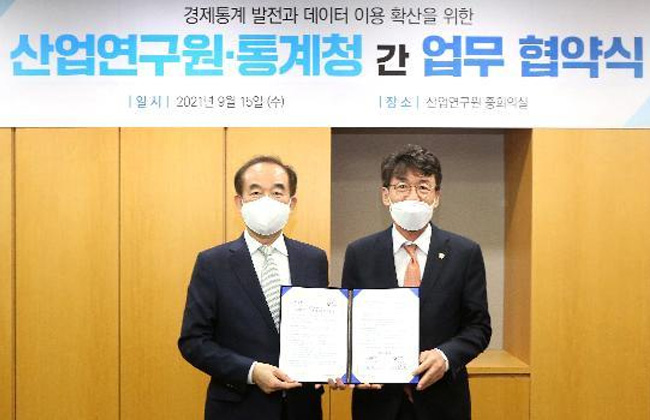Research Reports

We defined and classified innovation investment, and constructed innovation investment data based on macro and micro statistics. In this study, innovation investment as classified into six categories according to the innovative activities of the Oslo Manual. (① R&D investment, ② marketing investment, ③ Intellectual property(IP) investment, ④ human resource investment, ⑤ software investment, ⑥ organization investment) The innovation investment data based on macro statistics were constructed by reclassifying CHS intangible asset, which has the similar classification system with the innovation investment types defined in this study. we constructed data by reclassifying variables related to CHS intangible assets established by KISDI. Meanwhile, micro data refers to firm-level data. The innovation investment data based on micro data were constructed using financial statements provided by KISVALUE and R&D cost information on the cost statement provided by KISLINE. The data was constructed by matching types of innovation investment and accounts in financial statements. Each type of investment is classified into the types included in the asset account, the types included in the expense account, and the type included in both the asset and expense account. software and IP investment are included in the asset account, so the process of converting assets into investment(flow) is required. Marketing and human resource investment are included in the expense account, so there is no need to convert them into flow data. R&D investment is included in the assets and expenses account, so the process of converting assets in flow data is necessary. After data construction, an asymmetric resistance fence method was used to detect outliers, and then firms with outliers were removed from the data.
The result of the analysis using macro-statistics-based innovation investment data are as follows. The scale of innovation investment is gradually expanding in all industries, manufacturing and service industries. Also, the manufacturing sector shows a relatively high R&D concentration compared to the service sector. Furthermore, looking at the average annual investment growth rate by types of innovation investment, R&D investment and software investment have increased on average in most manufacturing and service industries, whereas organization investment shows a negative average annual investment growth rate in both industries. On the other hand, the trend of the average annual growth rate varies depending on the characteristics of industries. Investment in human resource contracted during the sample period in most industries of manufacturing sector, but the investment polarization pattern among the industries can be seen in service sector. In case of IP investment, the polarization phenomenon was evident due to difference of the nature of the industries within sectors. Also, in the case of marketing investment, the industries of service sector shows an increasing pattern while the industries of manufacturing sector shows a decreasing pattern.
The results of the analysis using micro-statistics-based innovation investment data are as follows. The scale of innovation investment in all domestic industries has increased and its ratio to sales in 2020 is slightly higher than that in 2001. Innovation investment in the manufacturing sector increased to 4 times compared to 2001 and the ratio to sales increased to 3.2%. As the proportion of investment in the top 10% of firms insales has decreased,theproblemofimbalance inthe investment structure is somewhat alleviated.
The results of examining the structure of innovation investment by dividing the manufacturing industry into three types - the ICT, machinery, and materials sector - are follows. The scale of innovation investment expanded the most in the ICT sector, followed by machinery and materials. The ratio of innovation investment to scales was also the largest in the ICT sector, so it was confirmed that the investment propensity was higher in this sector thanthat of other sectors.Inaddition, R&D investment has a structure that is about six times higher than non-R&Dinvestment. This is characterized by animbalanced relationship between R&D and non-R&D investment. The result of examining the structure of innovation investment by dividing the manufacturing industry by technology levels are follows. The scale of innovation investment and the ratio to sales expanded the most in hightechnology group, followed by low technology and middle technology group. In the mid-tech group, R&D investment took up to about 83% of the total investment, showing a relatively large proportion. Also, it can be seen that only a small number of firms makes innovation investment with large scales.
When looking at the service industry by three types, the innovation investment in producer and social/personal service sector has increased by about 2.6 times, and distribution service sector has expends the innovation investment by 4.2 times during sample period. However, innovation investment to sales ratio in all three sectors stays under 1%, which implies that the expenditure on innovation investment by service firms is insignificant. The proportion onR&Dinvestment was the highest in producer service sector, and in non-R&D investment, marketing investment was largest in all three service sectors.
Meanwhile, when analyzing innovation investment by firm size, it shows that the amount ofinnovationinvestment insmall andmedium-sized enterprises(SMEs) increased relatively quickly and concentrated onR&D investment. In the manufacturing sector, the scale of innovation investment expends in all firm size and most investment is heavily concentrated onR&Dinvestment. In service sector, the ratio of innovation investment to sales is in only 0~1% range for all firmsizes, which implies a significantly week level. The ratio of R&D investment is relatively higher than that of non-R&D investment and in non-R&D investment, marketing investment is relatively large.
In addition, we attempts to identify firm’s perceptions of innovation investment, difficulties, and policy-related demands by conducting a survey. First, it is found that there is a gap between the innovation investment perceived by firms and the innovation investment actually implemented. These results could be due to the lack of awareness of the effectiveness and efficiency of the various innovation investment. Also,the internal difficulties facedby firms include the lackof professionals and the burden of financing, and the external difficulties include burden of external financing and the inadequacy of the support system. Furthermore, it was found that the awareness of innovation investment support program was low, and the proportion of firms with experience in using support program was even lower. Therefore, the government should design policies in consideration of the difficulties that firms face in implementing innovation investments.
The discussions on various innovative investment and related policies have continued, and its necessity has been re-emerging with the recent economic structural change. However, the current innovation investment support program is heavily concentrated on R&D investment. Thus, for successful innovation, various innovation investment must be made in parallel withinvestment inR&D.Inthis regard, the structureofinnovation investment focused only on R&D investment can rather impair R&D efficiency. Therefore, in order to increase the success rate of innovation activities, it is necessary to examine the economic contribution of each type of innovation investment and to determine the size and availability of policy support for each type of innovation investment based on the research results.

The works on this page are licensed for fair use under the provisions of the Korea Open Government License. See kogl.or.kr for more information.
Please enter the security text below
to prevent email collection
Please check the information of the person in charge.
연구과제 제안이 접수되었습니다.
신청이 접수되었습니다.


View Summary
코로나19 발생 이후 대부분의 고용 관심사가 항공 및 여행서비스, 음식·숙박 서비스 등 주로 서비스 업종에 집중된 상황에서 본 연구는 최근 그 중요성이 강조되고 있는 제조업의 고용변화를 살펴보았다. 분석에 따르면, 코로나19 이후 제조업 고용은 비교적 큰 충격 없이 빠르게 회복하는 모습을 보이고 있다. 제조업 고용은 서비스업에 비해 큰 충격 없이 유지되고 있고, 코로나19 직후 2020년 상반기에 약간 하락하였지만 하반기부터 회복 추세를 보이고 있으며, OECD 주요국의 제조업과 비교하여도 일본과 함께 고용 충격이 비교적 작게 나타나고 있다. 그러나 전반적으로 양호한 고용 성적에도 불구하고 제조업 내 특성 별로는 차이가 나타나는 것으로 보인다. 종사상 지위 별로 보면, 임시·일용직, 고용원이 있는 자영업자에서 고용 충격이 상대적으로 크게 나타났고, 상용직과 고용원이 없는 자영업자는 큰 충격이 없는 것으로 나타났다. 제조업 규모별로는 300인 이상의 경우 코로나 발생 초기 약간의 충격 이후 고용이 빠르게 반등하면서 코로나 이전보다 고용이 더 증가한 반면, 이보다 작은 규모의 제조업체들의 경우 고용 회복이 더디게 나타나고 있다. 고용의 중장기, 단기 추세선을 비교한 결과 제조업 업종에 따른 차이를 보였다. 코로나 발생 이전 3년간의 추세선을 2020년 1월부터 연장한 선과, 2020년 1월부터의 실제 자료를 이용한 단기 추세선을 비교한 결과, 의약품은 코로나19 발생 이전부터 시작하여 코로나19 발생 이후에도 견조한 증가세를 유지하고 있으며, 전자부품·컴퓨터, 기타운송장비, 가구는 코로나19 이후 오히려 고용 추세가 개선되었다. 그러나 다수 업종은 코로나 발생 이후 고용이 하락하였는데, 특히, 비금속광물, 1차금속, 금속가공 분야나 인쇄·기록매체 업종에서 하락이 상대적으로 크게 나타났다.
The following information is provided.
inform@kiet.re.krPlease complete the CAPTCHA below.
[전지적키에트시점] (Eng sub)심상치 않은
국내 대기업 움직임??
KIET 시점에서 보는 미래 로봇 산업 전망은
어떨까요?
경제전문가가 알려드립니다!
(산업연구원 박상수 실장)


